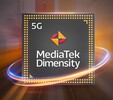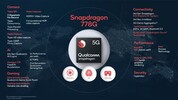MediaTek Dimensity 6080 vs Qualcomm Snapdragon 778G 5G
MediaTek Dimensity 6080
► remove from comparison
The MediaTek Dimensity 6080 (MT6833V/MT6833GP) is an ARM-based SoC (system-on-a-chip) manufactured by TSMC using the 6 nm process. It was specially designed for use in Android smartphones and is in the lower mid-range in terms of performance. It supports all current mobile communication standards, including 5G Sub6.
The SoC is identical to the MediaTek Dimensity 810 the only difference is that the Dimensity 6080 can cope with a camera resolution of up to 108 megapixels.
The CPU works with a total of eight cores, which are divided into two clusters. One has two ARM Cortex-A76 power cores with up to 2.4 GHz each, while the other has six ARM Cortex-A55 energy-saving cores with up to 2.0 GHz each. LPDDR4x RAM with 2,133 MHz can be used as RAM and UFS 2.2 is supported as internal memory.
In terms of connectivity, dual 5G (Sub6) with a theoretical peak download speed of up to 2.77 GBit/s is available, as well as Wi-Fi 5 and Bluetooth 5.1.
The integrated graphics unit ARM Mali-G57 MP2 can power displays with a resolution of up to 2,520 x 1,080 pixels (Full HD+) and a refresh rate of up to 120 Hz.
Qualcomm Snapdragon 778G 5G
► remove from comparison
The Qualcomm Snapdragon 778G 5G (SDM778G 5G Mobile Platform) is a fast mid-range ARM-based SoC largely found on Android tablets and smartphones. It integrates eight cores (octa-core) divided into two clusters. A fast performance cluster with four cores based on the ARM Cortex-A78 architecture with up to 2.4 GHz and a power efficiency cluster with four small ARM Cortex-A55 cores at up to 1.8 GHz. Depending on the workload only single clusters or all cores can run at different clock speeds.
Thanks to the new Cortex-A78 cores, the CPU performance increases by up to 40% compared to the old Snapdragon 768G according to Qualcomm. In our benchmarks, the 778G is able to reach the performance of the old high end chip Kirin 990.
The integrated X53 5G modem supports up to 3.3 Gbps with sub 6Ghz. The FastConnect 6900 Wi-Fi modem supports the current Wi-Fi 6e standard with 6GHz.
The integrated Qualcomm Adreno 642L offers a 40% higher performance compared to the old Adreno 620 in the predecessor. This is partly thanks to the fast memory controller with LPDDR5-3200 support.
The integrated 6th gen AI engine called Hexagon 770 offers a 2x improvement and up to 12 TOPS of performance. The Spectra 570 ISP (image signal processor) supports up to three cameras. The satellite system supports all major standards like Beidou, Galileo, GLONASS and GPS.
The G specifies an optimized SoC for gaming and e.g. Qualcomm offers updates for the graphics driver.
The Snapdragon 778G is manufactured in the modern 6 nm process at TSMC (vs the 5LPE of the 780G).
| Model | MediaTek Dimensity 6080 | Qualcomm Snapdragon 778G 5G | ||||||||||||||||||||||||||||||||
| Codename | Cortex-A76 / A55 | Kryo 670 (Cortex-A78/A55) | ||||||||||||||||||||||||||||||||
| Series | Mediatek Dimensity 6000 | Qualcomm Snapdragon | ||||||||||||||||||||||||||||||||
| Series: Snapdragon Kryo 670 (Cortex-A78/A55) |
|
| ||||||||||||||||||||||||||||||||
| Clock | 2000 - 2400 MHz | 1800 - 2400 MHz | ||||||||||||||||||||||||||||||||
| Cores / Threads | 8 / 8 2 x 2.4 GHz ARM Cortex-A76 6 x 2.0 GHz ARM Cortex-A55 | 8 / 8 | ||||||||||||||||||||||||||||||||
| Technology | 6 nm | 6 nm | ||||||||||||||||||||||||||||||||
| Features | Wi-Fi 5 (1T1R Antenna), 5G Multi-Mode 2.77 Gbps Download, GNSS: GPS L1CA+L5, BeiDou B1I+ B2a, Glonass L1OF, Galileo E1 + E5a, QZSS L1CA+ L5, NavIC | Adreno 642L GPU, X53 5G Modem, Hexagon 770 DSP, Spectra 570L ISP, Wi-Fi 6E | ||||||||||||||||||||||||||||||||
| iGPU | ARM Mali-G57 MP2 | Qualcomm Adreno 642L | ||||||||||||||||||||||||||||||||
| Architecture | ARM | ARM | ||||||||||||||||||||||||||||||||
| Announced | ||||||||||||||||||||||||||||||||||
| Manufacturer | www.mediatek.com | www.qualcomm.com |
Benchmarks
Average Benchmarks MediaTek Dimensity 6080 → 100% n=16
Average Benchmarks Qualcomm Snapdragon 778G 5G → 115% n=16
* Smaller numbers mean a higher performance
1 This benchmark is not used for the average calculation












